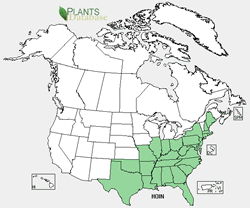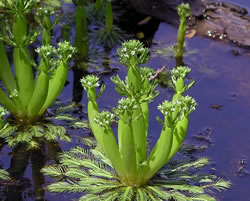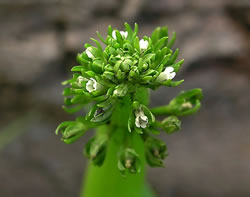Plant of the Week
 Range map of Hottonia inflata. States are colored green where the species may be found.
Range map of Hottonia inflata. States are colored green where the species may be found.
 A very unusual sight, a large colony of featherfoil in calm, shallow, water. Photo © Craig Fraiser.
A very unusual sight, a large colony of featherfoil in calm, shallow, water. Photo © Craig Fraiser.
 Note the multiple inflorescence stalks and the emersed/floating pinnatifid leaves and white flowers. Photo © Craig Fraiser.
Note the multiple inflorescence stalks and the emersed/floating pinnatifid leaves and white flowers. Photo © Craig Fraiser.
 In this close-up of a featherfoil inflorescence note that the flowers occur in a whorl around the inflated stalk. Photo © Craig Fraiser.
In this close-up of a featherfoil inflorescence note that the flowers occur in a whorl around the inflated stalk. Photo © Craig Fraiser.
American Featherfoil (Hottonia inflata)
Featherfoil is a very beautiful and extraordinarily interesting aquatic wildflower. At first glance, it appears to be just floating on the water’s surface; however, there is an underwater stem and root system. You are most likely to come across featherfoil inhabiting shallow pools, ditches, swamps, lakes, and beaver ponds. Generally sporadic in occurrence, featherfoil occurs disjunctly on the Atlantic and Gulf coastal plains, Maine to Georgia, west to east Texas, and northward up the Mississippi river to Missouri and Illinois and then up the Ohio river to include just a few known occurrences Indiana (two occurrences), Ohio (possibly extirpated), and West Virginia one occurrence.
Featherfoil is a member of the primrose family (Primulaceae). Linnaeus named the genus Hottonia for the Dutch botanist Petrus Hotton. There are two species H. inflata in the United States and H. palustris in Europe.
Featherfoil is an aquatic herb, annual or perennial, with a submergent stem and fibrous roots. The leaves are submergent to floating; alternate, opposite or whorled; pinnately or bipinnately divided; linear or filiform. The inflorescence stalks are a partially immersed, floating cluster; each stalk spongy-inflated. The inflorescence is a series of whorled, sessile umbels occurring where stalk becomes constricted. Flowers are numerous, white, yellow, or violet. The fruit is a rounded capsule containing numerous, tiny, brown seeds.
Conservation Concern
Featherfoil does best in shallow, stable, ponds, ditches, and swamps. Much of its historical habitat has been loss to development, draining of wetlands, siltation, and the historical unsustainable harvest of beavers throughout its range. With the reestablishment of beavers in the eastern United States and subsequent increase in the number of beaver ponds there is hope that featherfoil will also become reestablished throughout its historic range. Beaver ponds provide the ideal habitat for featherfoil, shallow waters with a steady water level. It is thought that mallards and wood ducks distributed the tiny seeds from one beaver pond to another. Beavers are also thought to be a dispersal mechanism as well by gathering seed-containing mud from their pond to build and repair their dam structures.
NatureServe ranks Hottonia inflata G4 “apparently secure”; stating that it is estimated that there are over 100 occurrences. However, Maine, New Hampshire, Rhode Island, New Jersey, Maryland, West Virginia, North Carolina, South Carolina, Georgia, and Mississippi rank Hottonia inflata S1 “critically imperiled;” New York, Delaware, Alabama, Tennessee, Oklahoma, Missouri, Illinois, and Indiana rank Hottonia inflata S2 “imperiled;’ Massachusetts, Connecticut, Virginia and Texas rank Hottonia inflata S3 “vulnerable;” presumed extirpated” from Pennsylvania and “possibly extirpated” from Ohio; Kentucky ranks Hottonia inflata S4 “apparently secure;” and it is not ranked or under review in Louisiana and Arkansas.

